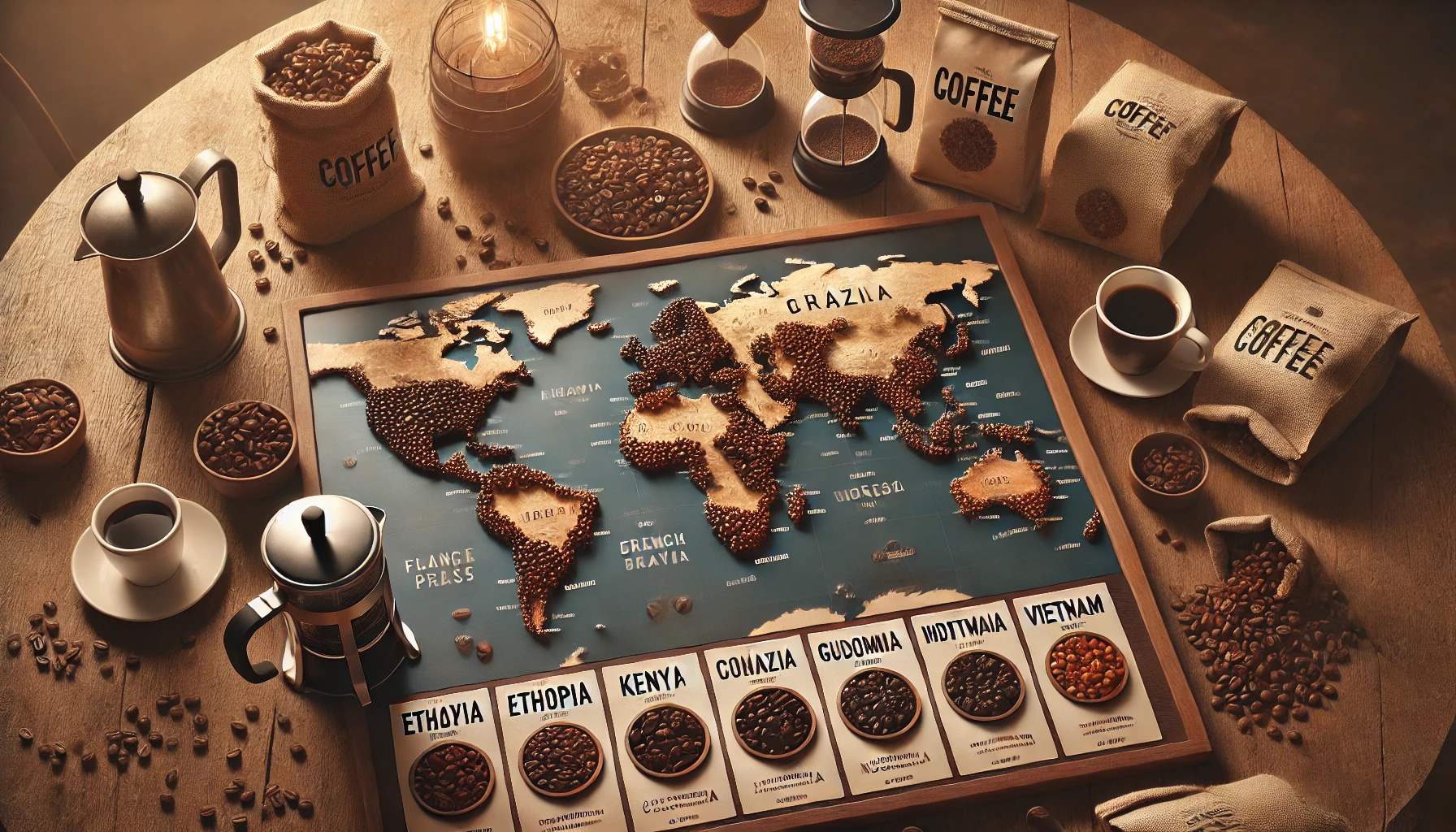Not all coffee beans are created equal—and where your coffee comes from plays a major role in how it tastes. Whether you’re sipping a fruity Ethiopian pour-over or a chocolatey Brazilian espresso, you’re experiencing the terroir, processing methods, and growing traditions of that region.
In this beginner-friendly guide, you’ll learn how coffee bean origins influence flavor, how to identify regional characteristics, and how to explore beans from around the world with confidence.
Why Coffee Origin Matters
Just like wine or chocolate, coffee is shaped by its environment and process:
- Altitude affects acidity and complexity
- Soil and climate influence body and aroma
- Processing methods (washed, natural, honey) shape sweetness and clarity
- Varietals (Arabica subtypes) add further nuance
Coffee beans are agricultural products, and understanding their origins allows you to appreciate them beyond caffeine and taste.
Major Coffee-Growing Regions
Most of the world’s coffee is grown in the “Coffee Belt”, a band between the Tropics of Cancer and Capricorn. Within that belt, coffee from different continents offers distinct flavor profiles.
1. Africa
Ethiopia
- Birthplace of coffee
- Flavor notes: floral, blueberry, bergamot, jasmine
- Often naturally processed, enhancing fruitiness
- Great for light roasts and pour-over methods
Kenya
- Bright acidity, bold body
- Notes of blackcurrant, citrus, and tomato
- Known for washed processing and SL varietals
- Ideal for adventurous palates
2. Latin America
Brazil
- World’s largest producer
- Flavor notes: chocolate, nuts, mild fruit
- Often used in espresso blends
- Low acidity, high body, great for milk-based drinks
Colombia
- Balanced and smooth
- Notes of red fruit, caramel, citrus
- Washed processing dominates
- Widely accessible and versatile
Guatemala
- Volcanic soil = vibrant flavor
- Notes of cocoa, spice, tropical fruit
- Popular for specialty coffee and drip brews
3. Asia-Pacific
Indonesia (Sumatra, Java)
- Full-bodied and earthy
- Notes of spice, cedar, tobacco
- Often semi-washed (wet-hulled), giving a distinct funk
- Perfect for those who like bold, rustic flavors
Vietnam
- Primarily Robusta beans
- Used in strong drip coffee or instant blends
- Bitter, dark chocolate, smoky
- Key to traditional Vietnamese iced coffee
India
- Grows both Arabica and Robusta
- Notes of dark chocolate, pepper, low acidity
- Unique monsooned coffees (aged in humid conditions)
Flavor by Origin Cheat Sheet
| Region | Common Notes | Body | Acidity |
|---|---|---|---|
| Ethiopia | Floral, citrus, blueberry | Light | High |
| Kenya | Tomato, blackcurrant, winey | Medium | High |
| Brazil | Chocolate, nutty, smooth | Full | Low |
| Colombia | Caramel, fruit, balanced | Medium | Medium |
| Guatemala | Cocoa, spice, tropical fruit | Medium | Medium-High |
| Indonesia | Earthy, herbal, bold | Heavy | Low |
| Vietnam | Bitter, smoky, dark cocoa | Heavy | Low |
| India | Spicy, chocolatey, mellow | Medium | Low |
Washed vs Natural vs Honey Process
Origin is just one piece of the flavor puzzle—processing plays a big role too.
- Washed (Wet): Clean, bright, acidic
- Natural (Dry): Fruity, sweet, winey
- Honey: Balanced, smooth, often syrupy
Ethiopian naturals and Kenyan washed coffees are perfect examples of how processing highlights or softens regional traits.
How to Explore Origins as a Beginner
- Start with a sampler: Buy a tasting kit or box of beans from different countries
- Use consistent brew methods: Brew each origin the same way to compare flavor
- Keep a tasting journal: Note aroma, flavor, body, and finish
- Talk to your local roaster: Ask about origin, varietal, and processing
- Try single-origin coffees: Blends can be great, but origin-specific beans highlight terroir better
Popular Origins to Try First
- Colombia: Balanced, beginner-friendly
- Ethiopia: Great introduction to fruity, floral coffees
- Brazil: Smooth, chocolatey—great for milk drinks
- Guatemala: Offers both richness and acidity
- Sumatra (Indonesia): Bold and earthy for dark roast lovers
Final Thoughts: Let Your Taste Travel the World
Every cup of coffee tells a story of place—from the soil it was grown in to the hands that harvested it. By learning about bean origins, you unlock a world of flavors, cultures, and appreciation.
So the next time you brew a cup, take a moment to read the label and taste the journey. Your coffee passport is just beginning.
